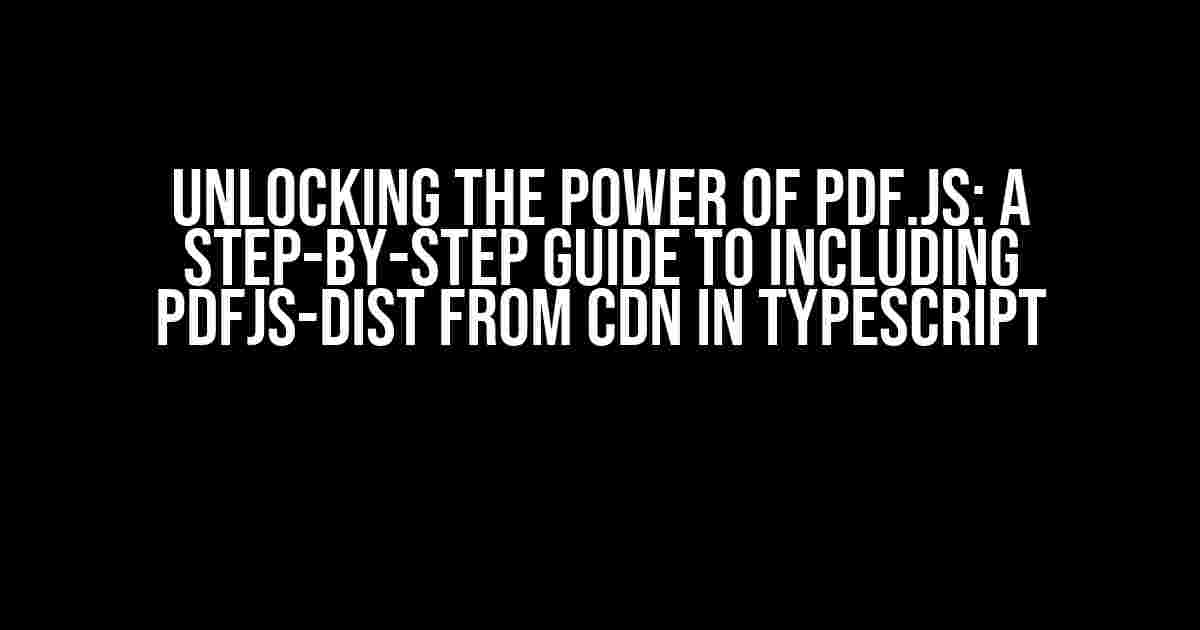Are you tired of struggling to display PDFs in your web application? Do you want to unlock the full potential of PDF.js without the hassle of setting up a local installation? Look no further! In this comprehensive guide, we’ll show you how to include pdfjs-dist from a CDN in your TypeScript project, so you can start rendering PDFs like a pro in no time.
What is PDF.js?
PDF.js is a JavaScript library developed by Mozilla that allows you to parse and render PDFs in the browser. It’s an open-source project that provides a powerful and flexible way to display PDFs, with support for features like text selection, zooming, and printing.
Why Use a CDN?
Using a CDN (Content Delivery Network) to include pdfjs-dist in your project offers several benefits:
- Faster page loads: By loading the library from a CDN, you can reduce the load on your server and improve page load times.
- Easy maintenance: With a CDN, you don’t need to worry about keeping the library up-to-date – the CDN provider handles updates for you.
- Reduced bandwidth usage: By offloading the library to a CDN, you can reduce the amount of bandwidth used by your server.
Getting Started with pdfjs-dist from CDN
Follow these simple steps to include pdfjs-dist from a CDN in your TypeScript project:
Step 1: Add the Script Tag
<script src="https://mozilla.github.io/pdf.js/build/pdf.js"></script>Add the above script tag to your HTML file, making sure to include it before your TypeScript code.
Step 2: Declare the PDFJS Global
declare var PDFJS: any;In your TypeScript file, declare the `PDFJS` global variable. This will allow you to use the PDF.js library without any issues.
Step 3: Create a PDF Viewer Instance
const pdfViewer = new PDFJS.PDFViewer({
container: document.getElementById('pdf-container'),
removePageCtrls: false,
});Create a new instance of the `PDFViewer` class, passing in a container element and any optional configuration settings.
Step 4: Load a PDF File
pdfViewer.setDocument('https://example.com/sample.pdf');Load a PDF file using the `setDocument` method, passing in the URL of the PDF file.
Step 5: Render the PDF
pdfViewer.render();Finally, call the `render` method to display the PDF in the browser.
| Property | Description |
|---|---|
| container | The HTML element that will contain the PDF viewer. |
| removePageCtrls | A boolean indicating whether to remove page controls (e.g., next/prev page buttons). |
Troubleshooting Common Issues
Encountering issues with your PDF.js setup? Here are some common solutions to get you back on track:
Issue: “PDFJS is not defined”
Solution: Make sure you’ve included the script tag correctly and declared the `PDFJS` global variable.
Issue: “Cannot find name ‘PDFJS'”
Solution: Check that your TypeScript configuration is set up correctly, and the `@types/pdfjs-dist` package is installed.
Issue: “PDF rendering is slow”
Solution: Optimize your PDF file by compressing images and reducing file size, or consider using a more powerful server to host your PDFs.
Conclusion
In this article, we’ve demonstrated how to include pdfjs-dist from a CDN in your TypeScript project, providing a comprehensive guide to getting started with PDF.js. By following these simple steps, you can unlock the full potential of PDF.js and start rendering PDFs like a pro in no time. Remember to troubleshoot common issues and optimize your PDF files for the best performance.
Bonus: Advanced PDF.js Features
Want to take your PDF.js skills to the next level? Here are some advanced features to explore:
- Text selection and copying
- Page zooming and scaling
- Printing and downloading PDFs
- Custom PDF viewer layouts and themes
With these advanced features, you can create a customized PDF viewing experience that meets your specific needs. Happy coding!
Final Thoughts
Including pdfjs-dist from a CDN is a convenient and efficient way to add PDF.js functionality to your TypeScript project. By following this guide, you can start rendering PDFs in the browser with ease, and explore advanced features to take your application to the next level. Happy coding, and don’t forget to share your PDF.js creations with the world!
Here are 5 Questions and Answers about “How to include pdfjs-dist from CDN so I can use it in a browser using typescript?”
Frequently Asked Question
Got questions about using pdfjs-dist from CDN with TypeScript in a browser? We’ve got answers!
Q1: What is the CDN link to include pdfjs-dist?
You can include pdfjs-dist from CDN using the following script tag: ``. This will load the latest version of pdfjs-dist.
Q2: How do I import pdfjs-dist in my TypeScript file?
You can import pdfjs-dist in your TypeScript file using the following line: `import * as pdfjsLib from ‘pdfjs-dist/build/pdf’;`. This assumes you have already included the script tag in your HTML file.
Q3: Do I need to install any additional dependencies for pdfjs-dist?
No, you don’t need to install any additional dependencies for pdfjs-dist. The CDN link includes all the necessary dependencies. However, if you want to use TypeScript definitions, you may need to install `@types/pdfjs-dist` using npm or yarn.
Q4: Can I use a specific version of pdfjs-dist from CDN?
Yes, you can use a specific version of pdfjs-dist from CDN by including the version number in the script tag. For example: ``. Replace `2.3.200` with the version number you want to use.
Q5: What if I want to use pdfjs-dist with a module loader like RequireJS?
If you want to use pdfjs-dist with a module loader like RequireJS, you’ll need to include the script tag with the `data-main` attribute set to your main JavaScript file. Then, in your main JavaScript file, you can use RequireJS to load pdfjs-dist as a module.
